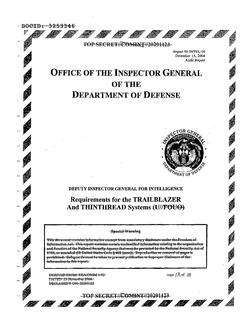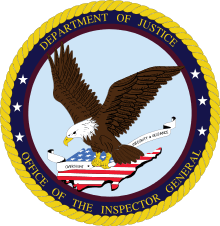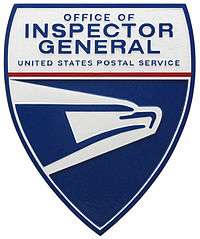Office of Inspector General (United States)
In the United States, the Office of Inspector General (OIG) is a generic term for the oversight division of a federal or state agency aimed at preventing inefficient or illegal operations within their parent agency. Such offices are attached to many federal executive departments, independent federal agencies, as well as state and local governments. Each office includes an Inspector General (or I.G.) and employees charged with identifying, auditing, and investigating fraud, waste, abuse, embezzlement and mismanagement of any kind within the executive department.
History
In the United States, other than the military departments, the first Office of Inspector General (OIG) was established by act of Congress in 1976[1] under the Department of Health and Human Services, to fight waste, fraud and abuse in Medicare, Medicaid, and more than 100 other HHS programs.[2] With approximately 1,600 employees, the OIG performs audits, investigations, and evaluations, to establish policy recommendations for decision-makers and the public.
Description
Federal offices of inspectors general
There are 73 federal offices of inspectors general,[3] a significant increase since the statutory creation of the initial 12 offices by the Inspector General Act of 1978.[4] The offices employ special agents (criminal investigators, often armed) and auditors. In addition, federal offices of inspectors general employ forensic auditors, or "audigators," evaluators, inspectors, administrative investigators, and a variety of other specialists. Their activities include the detection and prevention of fraud, waste, abuse, and mismanagement of the government programs and operations within their parent organizations. Office investigations may be internal, targeting government employees, or external, targeting grant recipients, contractors, or recipients of the various loans and subsidies offered through the thousands of federal domestic and foreign assistance programs.[5] The Inspector General Reform Act of 2008[6] (IGRA) amended the 1978 act[4] by increasing pay and various powers and creating the Council of the Inspectors General on Integrity and Efficiency (CIGIE).[7]

Some inspectors general, the heads of the offices, are appointed by the president and confirmed by the senate.[9] For example, both the inspector general of the U.S. Department of Labor and the inspector general of the U.S. Agency for International Development are presidentially appointed. The remaining inspectors general are designated by their respective agency heads,[10] such as the U.S. Postal Service inspector general.[11] Presidentially appointed IGs can only be removed, or terminated, from their positions by the President of the United States, whereas designated inspectors general can be terminated by the agency head.[12] However, in both cases Congress must be notified of the termination, removal, or reassignment.
While the IG Act of 1978 requires that inspectors general be selected based upon their qualifications and not political affiliation, presidentially appointed inspectors general are considered political appointees and are often selected, if only in part and in addition to their qualifications, because of their political relationships and party affiliation. An example of the role political affiliation plays in the selection of an inspector general, and the resulting pitfalls, can be seen in the 2001 Republican appointment (and resignation under fire) of Janet Rehnquist[13] (daughter of former Chief Justice of the United States, William Rehnquist) to the post of inspector general for the U.S. Department of Health and Human Services.[14]
While all of the federal offices of inspector generals operate separately from one another, they share information and some coordination through the Council of Inspectors General on Integrity and Efficiency (CIGIE).[15] As of 2010, the CIGIE[16] comprised 68 offices. In addition to their inspector general members, CIGIE includes non-inspector general representatives from the federal executive branch, such as executives from the Office of Management and Budget, the Office of Personnel Management, the Office of Government Ethics, the Office of Special Counsel, and the Federal Bureau of Investigation. CIGIE also provides specialized training to the inspector general community.
Further evidence of coordination between federal offices of inspector generals can be seen by the public through the offices' shared website,[17] and the use of shared training facilities and resources, such as the Inspector General Criminal Investigator Academy (IGCIA),[18] and their Inspector General Community Auditor Training Team (IGCATS),[19] which are hosted by the Federal Law Enforcement Training Center (FLETC).
Evidence of the offices' return on investment to taxpayers can be seen through their semi-annual reports to Congress, most of which are available on each office's website.[3]
Since the post-9/11 enactment of the Homeland Security Act of 2002,[20] resulting in the amendment of the IG Act of 1978, Section 6e, most presidentially appointed IG special agents have had full law enforcement authority to carry firearms, make arrests, and execute search warrants. Prior to this time, most presidentially appointed IG and some designated IG special agents had the equivalent law enforcement authorities as a result of other statutes or annually required deputation by the U.S. Marshals Service. The 2002 amendment to the IG Act of 1978 made most deputation of presidentially appointed IG special agents unnecessary. Some designated IG special agents, however, still have full law enforcement authority today by virtue of this continued deputation. Some OIGs employ no criminal investigators and rely solely on administrative investigators, auditors, and inspectors.
U.S. offices of inspector general
Presidentially appointed inspectors general
- Agency for International Development (AID-OIG)[21]
- United States Department of Agriculture (USDA-OIG)[22]

- Central Intelligence Agency (CIA-OIG)
- United States Department of Commerce (DOC-OIG)[23]
- Corporation for National and Community Service (CNCS-OIG)[24]
- Office of the Inspector General, Department of Defense (DOD-OIG)[25]
- United States Department of Education (ED-OIG)[26]
- United States Department of Energy (DOE-OIG)[27]
- Environmental Protection Agency (EPA-OIG)[28]
- Export-Import Bank of the United States (EIB-OIG)[29]
- Federal Deposit Insurance Corporation (FDIC-OIG)[30]
- General Services Administration (GSA-OIG)[31]
- United States Department of Health and Human Services (HHS-OIG)[14]
- Department of Homeland Security Office of Inspector General (DHS-OIG)[32]
- United States Department of Housing and Urban Development (HUD-OIG)[33]
- United States Department of the Interior (DOI-OIG)[34]
- United States Department of Justice Office of the Inspector General (DOJ-OIG)[35]

- United States Department of Labor Office of Inspector General (DOL-OIG)[36]

- National Aeronautics and Space Administration (NASA-OIG)[37]
- Nuclear Regulatory Commission (NRC-OIG)[38]
- United States Office of Personnel Management (OPM-OIG)[39]
- Railroad Retirement Board (RRB-OIG)[40]
- Small Business Administration (SBA-OIG)[41]
_seal_(USA).jpg)
- Social Security Administration (SSA-OIG)[42]
.jpg)
- United States Department of State – Office of Inspector General (OIG) for the U.S. Department of State and the Broadcasting Board of Governors (BBG) (DOS-OIG)[43]
- Tennessee Valley Authority (TVA-OIG)[44]
.png)
- Office of Inspector General for the Department of Transportation (DOT-OIG)[45]
- United States Department of the Treasury (Treasury OIG)[46]
- Treasury Inspector General for Tax Administration (TIGTA) of the Department of the Treasury[47]
- United States Department of Veterans Affairs (VA-OIG)[48]

Designated federal entity inspectors general
- National Railroad Passenger Corporation (Amtrak)[49]

- Appalachian Regional Commission (ARC-OIG)[50]
- Commodity Futures Trading Commission (CFTC-OIG)[51]
- Consumer Product Safety Commission (CPSC-OIG)[52]
- Corporation for Public Broadcasting (CPD-OIG)[53]
- Denali Commission[54]
- Election Assistance Commission (EAC-OIG)[55]
- Equal Employment Opportunity Commission (EEOC-OIG)[56]
- Farm Credit Administration (FCA-OIG)[57]
- Federal Communications Commission (FCC-OIG)[58]
.jpg)
- Federal Election Commission (FEC-OIG)[59]
- Federal Housing Finance Board (FHFB-OIG)[60]
- Federal Labor Relations Authority (FLRA-OIG)[61]
- Federal Maritime Commission (FMC-OIG)[62]
- Federal Reserve Board (FRB-OIG)[63]
- Federal Trade Commission (FTC-OIG)[64]
- United States International Trade Commission (USITC-OIG)[65]
- Legal Services Corporation (LSC-OIG)[66]
- National Archives and Records Administration[67]
- National Credit Union Administration (NCUA-OIG)[68]
- National Endowment for the Arts (NEA-OIG)[69]
- National Endowment for the Humanities (NEH-OIG)[70]
- National Labor Relations Board (NLRB-OIG)[71]
- National Science Foundation (NSF-OIG)[72]
- Peace Corps[73]
- Pension Benefit Guaranty Corporation (PBGC-OIG)[74]
- Postal Regulatory Commission (formerly Postal Rate Commission) (PRC-OIG)[75]
- United States Postal Service Office of Inspector General (USPS-OIG)[11]

- Securities and Exchange Commission (SEC-OIG)[76]
- Smithsonian Institution[77]
Special inspectors general
- Special Inspector General for Afghanistan Reconstruction (SIGAR)[78] – appointed by the president
- Special inspector general for the Troubled Asset Relief Program (SIGTARP)[79] – appointed by the president with Senate confirmation
Legislative agency inspectors general
- Architect of the Capitol (AOC-OIG)[80]
- United States Capitol Police (USCP-OIG)[81]
- Government Accountability Office (GAO-OIG)[82]
- Government Publishing Office (GPO-OIG)[83]
- Library of Congress (LOC-OIG)[84]
Other federal inspectors general
- Director of National Intelligence, Office of (ODNI-OIG)
U.S. military
Within the United States Armed Forces, the position of inspector general is normally part of the personal staff serving a general or flag officer in a command position. The inspector general's office functions in two ways. To a certain degree they are ombudsmen for their branch of service. However, their primary function is to ensure the combat readiness of subordinate units in their command.
An armed services inspector general also investigate noncriminal allegations and some specific criminal allegations, to include determining if the matter should be referred for criminal investigation by the service's criminal investigative agency.
The Air Force Inspector General Complaints Program was established to address the concerns of Air Force active duty, reserve, and Guard members, civilian employees, family members, and retirees, as well as the interest of the Air Force. One of the first responsibilities of the Air Force inspector general is to operate a credible complaints program that investigates personnel complaints: Fraud, Waste, and Abuse (FWA) allegations; congressional inquiries; and issues involving the Air Force mission. Personnel complaints and FWA disclosures to the IG help commanders correct problems that affect the productivity, mission accomplishment, and morale of assigned personnel, which are areas of high concern to Air Force leaders at all levels.[85]
See:
- Inspector General of the Air Force, established by the U.S. Air Force in 1948.
- Inspectors General of the U.S. Army, dating back to 1777.
- Naval Inspector General, established by the U.S. Navy in 1942.
- Office of the Inspector General, U.S. Department of Defense established 1982.
Stark Law and Anti-Kickback Statute Enforcement
The OIG develops and distributes resources to assist the health care industry in its efforts to comply with the Nation's fraud and abuse laws and to educate the public about fraudulent schemes so they can protect themselves and report suspicious activities.[2]
In recent years, the OIG has made an effort to target hospitals and healthcare systems for Stark Law and Anti-Kickback Statute violations pertaining to the management of physician compensation arrangements.[86] In 2015, a fraud alert was issued to publicize the OIG's intent to further regulate such non-compliance.[87] In light of such efforts and consequent record-breaking settlements, healthcare experts have begun to call for the transition from paper based physician time logging and contract management to automated solutions.[88]
Criticism
Inspectors General have also been criticized for being, rather than guardians of whistleblowers, instead, ineffective, inactive, or at worst, instruments by which whistleblowers are persecuted. One example is from the Securities and Exchange Commission OIG. In a 2011 article by Matt Taibbi, SEC whistleblowers said that complaining to the SEC OIG was "well-known to be a career-killer."[89] Another example is from whistleblower Jesselyn Radack's book Canary in the Coalmine, in which she describes her experience complaining to the Department of Justice OIG; instead of helping her, the IG office helped the DOJ get her fired and restricted from practicing as a lawyer.[90] Another example is from the Thomas Andrews Drake case, in which several complainants to the Department of Defense OIG over NSA's Trailblazer Project were later raided by the FBI and some threatened with criminal prosecution.[91]
References
- ↑ Pub.L. 94–505
- 1 2 "oig.hhs.gov".
- 1 2 Ignet.gov Archived 2005-03-08 at the Wayback Machine.
- 1 2 Ignet.gov Archived 2011-05-18 at the Wayback Machine.
- ↑ Federal domestic and foreign assistance programs
- ↑ Ignet.gov Archived 2010-11-24 at the Wayback Machine.
- ↑ Akin Gump Strauss Hauer & Feld LLP. Stimulus Bill and Strings: Massive Federal Spending Will Be Accompanied by Increased Inspectors General Oversight and Investigations. Inspectors General Investigations Alert. Bill was passed as H.R.928 - Improving Government Accountability Act (OpenCongress link Archived 2010-04-30 at the Wayback Machine.).
- ↑ Redacted version of the DoD Inspector General audit, obtained through the Freedom of Information Act by the Project on Government Oversight and others. POGO Obtains Pentagon Inspector General Report Associated With NSA Whistleblower Tom Drake, By Nick Schwellenbach, Project on Government Oversight, 2011 6 22, http://pogo.typepad.com , and Too Classified to Try Myth in Failed Drake Prosecution, Jesselyn Radack, DailyKos, 6/11/11
- ↑ Ignet.gov Archived August 13, 2009, at the Wayback Machine. (PDF)
- ↑ Ignet.gov Archived 2005-03-24 at the Wayback Machine.
- 1 2 "Home Page - USPS Office of Inspector General". www.uspsoig.gov.
- ↑ Ignet.gov Archived 2005-03-05 at the Wayback Machine.
- ↑ Phillyburbs.com Archived 2008-12-04 at the Wayback Machine.
- 1 2 Services, Office of Inspector General, Department of Health and Human. "Office of Inspector General - U.S. Department of Health and Human Services". oig.hhs.gov.
- ↑ Ignet.gov Archived 2005-03-05 at the Wayback Machine.
- ↑ Ignet.gov Archived 2005-03-05 at the Wayback Machine.
- ↑ "IGNET - Council of the Inspectors General on Integrity and Efficiency; IGnet". www.ignet.gov.
- ↑ ignet.gov Archived 2008-12-10 at the Wayback Machine.
- ↑ Inspector General Community Auditor Training Team (IGCATS) Archived 2008-12-10 at the Wayback Machine.
- ↑ Homeland Security Act of 2002 (PDF)
- ↑ Usaid.gov Archived 2009-10-09 at the Wayback Machine. OIG
- ↑ Usda.gov OIG
- ↑ Oig.doc.gov/oig Archived 2010-06-17 at the Wayback Machine.
- ↑ Nationalservice.gov Archived 2009-10-21 at the Wayback Machine. CNCS-OIG
- ↑ "Home". www.dodig.mil.
- ↑ Ed.gov OIG
- ↑ Ig.energy.gov OIG
- ↑ Epa.gov OIG
- ↑ Exim.gov OIG
- ↑ "Federal Deposit Insurance Corporation Office of Inspector General -". www.fdicoig.gov.
- ↑ "GSA Office of Inspector General". oig.gsa.gov.
- ↑ Dhs.gov Archived 2011-09-29 at the Wayback Machine. OIG
- ↑ "Hud.gov".
- ↑ "DOI OIG". www.doioig.gov.
- ↑ "USDOJ Office of the Inspector General". www.justice.gov.
- ↑ Oig.dol.gov
- ↑ "NASA OIG". oig.nasa.gov.
- ↑ "Nrc.gov".
- ↑ "Our Inspector General". U.S. Office of Personnel Management.
- ↑ Rrb.gov Archived 2009-08-13 at the Wayback Machine.
- ↑ "Inspector General - The U.S. Small Business Administration - SBA.gov". www.sba.gov.
- ↑ "Office of the Inspector General, SSA - Social Security Administration". www.socialsecurity.gov.
- ↑ "StateOIG.gov". oig.state.gov.
- ↑ OIG. "Home - TVA OIG - Office of the Inspector General". oig.tva.gov.
- ↑ "Office of Inspector General - U.S. Department of Transportation - Calvin L. Scovel III, Inspector General". www.oig.dot.gov.
- ↑ Ustreas.gov OIG
- ↑ Treas.gov Archived December 26, 1996, at the Wayback Machine.
- ↑ "Va.gov/oig". Archived from the original on 2016-06-17. Retrieved 2016-06-19.
- ↑ Amtrakoig.com Archived 2009-09-25 at the Wayback Machine.
- ↑ Arc.gov Archived 2009-10-21 at the Wayback Machine.
- ↑ "Office of the Inspector General - U.S. COMMODITY FUTURES TRADING COMMISSION". www.cftc.gov.
- ↑ Cpsc.gov Archived 2010-07-01 at the Wayback Machine.
- ↑ ernestosilva (12 March 2015). "Office of the Inspector General". www.cpb.org.
- ↑ oig.denali.gov. oig.denali.gov (2015-07-28). Retrieved on 2015-08-27.
- ↑ "Inspector General - US Election Assistance Commission". www.eac.gov.
- ↑ "Office of Inspector General". www.eeoc.gov.
- ↑ "Inspector general - Farm Credit Administration". www.fca.gov.
- ↑ "Inspector General". 1 December 2010.
- ↑ "FEC.gov". FEC.gov.
- ↑ Fhfa.gov Archived 2010-06-11 at the Wayback Machine.
- ↑ "Office of Inspector General - FLRA". www.flra.gov.
- ↑ Fmc.gov Archived 2010-06-13 at the Wayback Machine.
- ↑ "OIG: Office of Inspector General". www.federalreserve.gov.
- ↑ "Office of Inspector General". 7 June 2013.
- ↑ Usitc.gov/oig Archived 2010-07-03 at the Wayback Machine.
- ↑ "Legal Services Corporation - Office of Inspector General". www.oig.lsc.gov.
- ↑ "National Archives Office of Inspector General (OIG)". 15 August 2016.
- ↑ Ncua.gov Archived 2010-05-27 at the Wayback Machine.
- ↑ Arts.endow.gov Archived 2010-06-01 at the Wayback Machine.
- ↑ "Office of the Inspector General". National Endowment for the Humanities.
- ↑ Nlrb.gov Archived 2010-12-06 at the Wayback Machine.
- ↑ "Office of Inspector General (OIG) - NSF - National Science Foundation". www.nsf.gov.
- ↑ Peacecorps.gov Archived 2010-06-17 at the Wayback Machine.
- ↑ "Oig.pbgc.gov".
- ↑ Prc.gov Archived 2009-08-31 at the Wayback Machine.
- ↑ Sec-oig.gov Archived 2009-08-26 at the Wayback Machine.
- ↑ "Office of the Inspector General -Smithsonian". www.si.edu.
- ↑ "SIGAR - Special Inspector General for Afghanistan Reconstruction". www.sigar.mil.
- ↑ "Office of the Special Inspector General for the Troubled Asset Relief Program". Office of the Special Inspector General for the Troubled Asset Relief Program.
- ↑ "Office of Inspector General".
- ↑ Uscapitolpolice.gov/oig Archived 2010-05-27 at the Wayback Machine.
- ↑ "Office of the Inspector General". www.gao.gov.
- ↑ "Overview and Hotline". www.gpo.gov.
- ↑ "Office of the Inspector General - About the Library - Library of Congress".
- ↑ Boone Nicolls, Airman's Guide. Stackpole Books, 2007 ( ISBN 978-0-8117-3397-7), p. 135.
- ↑ "Becker's Hospital Review".
- ↑ "Becker's Hospital Review" (PDF).
- ↑ "Becker's Hospital Review".
- ↑ Taibbi, Matt (August 17, 2011). "Is the SEC Covering Up Wall Street Crimes?". Rolling Stone.
- ↑ Canary in the Coalmine, Jesselyn Radack, 2006, ISBN 1-4276-0974-8
- ↑ Mayer, Jane (May 2011). "The Secret Sharer". The New Yorker.
Further reading
- Nadia Hilliard, The Accountability State: US Federal Inspectors General and the Pursuit of Democratic Integrity (2017) excerpt